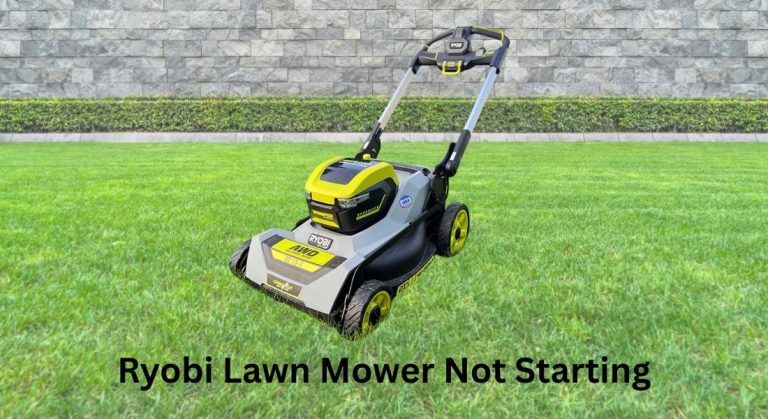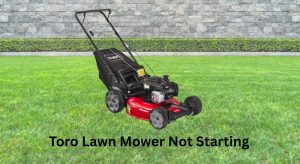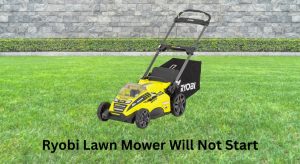You’re ready to mow, but your Ryobi lawn mower won’t start—frustrating, especially when the lawn is overdue. Whether you have a Ryobi 40V battery mower, a corded electric, or a gas push mower, there’s often a quick fix. Try this first: for battery models, remove the battery, press the battery’s fuel gauge to confirm charge, clean the contacts, reinsert firmly until it clicks, and hold the start button while pulling back the safety bail. For gas models, check the fuel: if it’s older than 30 days, drain and refill with fresh gasoline and try again.
This comprehensive guide covers all models—battery, corded, and gas. You’ll learn the most common causes, quick-start fixes, step-by-step diagnostic methods, and maintenance tips to prevent future issues. By the end, you’ll know exactly how to get your Ryobi lawn mower starting reliably again and when to call a pro.
Common Causes of a Ryobi Lawn Mower Not Starting

Battery (40V/18V) Models
- Dead or unseated battery: Battery not fully charged or not clicked in.
- Dirty/corroded contacts: Oxidation on battery or mower terminals.
- Safety interlock not engaged: Start sequence not followed, handle/bail not pulled.
- Faulty start key or safety key missing: Many Ryobi models require a removable key.
- Overheated battery or mower: Thermal protection prevents start until cooled.
- Defective battery or BMS fault: Battery’s internal management can lock out.
- Blade jam/obstruction: Grass buildup preventing motor spin.
- Wet or damp electronics: Moisture under the deck or in control housing.
- Faulty switches or controller: Worn start button, bad bail switch, or motor controller failure.
Corded Electric Models
- No power to outlet: Tripped breaker, GFCI outlet tripped.
- Damaged extension cord: Cut, frayed, or wrong gauge causing voltage drop.
- Safety bail not engaged or faulty switch.
- Debris jam at blade or motor.
- Internal wiring or motor failure.
Gas (Ryobi 160cc/190cc and similar)
- Stale fuel or wrong fuel mix: Gas older than 30–60 days, ethanol issues, water contamination.
- Fouled spark plug: Carboned, wet, or damaged electrode.
- Clogged carburetor/jets: Gummed from old fuel.
- Dirty air filter: Chokes airflow and floods engine.
- Safety lever not engaged: Bail switch must be fully pulled.
- Low oil level or oil sensor lockout (if equipped).
- Flooded engine: Too many priming presses or excessive choke.
- Blade jam: Grass or twine wrapped around blade.
- Ignition coil failure or sheared flywheel key (less common).
How to Fix a Ryobi Lawn Mower Not Starting

Method 1: Quick Start Basics (All Models)
Time: 5–10 minutes
Diagnosing the Issue
- Determine your model type: battery, corded, or gas.
- Note behavior: no click/no sound, click then stops, hum, or brief spin then die.
Fix Steps
- Safety first
– Remove battery or unplug cord; for gas, pull spark plug boot before working around blade. - Clear the deck
– Turn mower on its side with air filter up (gas) to avoid flooding.
– Remove packed grass, twine, or debris from blade and motor area. - Check safety bail and start sequence
– For Ryobi battery models: Insert safety key (if applicable). Press and hold start button, then pull and hold the bail lever. Release start button after the motor engages.
– For corded: Hold bail lever firmly while pressing the start switch.
– For gas: Fully pull the bail to engage engine brake and ignition. - Level surface and dry conditions
– Ensure mower is upright, not water-soaked, and ambient temperature is moderate.
Testing
- Try starting again using the correct sequence. If still dead, proceed to the specific method for your model.
Method 2: Battery Ryobi Mower Deep Troubleshoot (40V/18V)
Time: 15–30 minutes
Diagnosing the Issue
- Battery LEDs: Press fuel gauge. No lights = deeply discharged or faulty. One blinking LED can indicate thermal or fault state depending on model.
- Mower behavior: No response vs. brief twitch suggests contact or controller problem.
Fix Steps
- Battery and charger check
– Place battery on a Ryobi compatible charger (e.g., OP404, OP406). Observe charger lights:- Solid green: fully charged.
- Flashing green: charging.
- Red or alternating red/green: error or temperature lockout. Let battery cool/warm for 30–60 minutes, then retry.
- Clean contacts
– Use a dry cloth or a cotton swab with 70% isopropyl alcohol to clean battery blades and mower terminals. For light corrosion, gently rub with a pencil eraser. Do not scratch plating. - Reseat battery firmly
– Insert until you hear and feel a solid click. Tug gently to confirm lock. - Check safety key and interlocks
– Ensure the removable key is inserted fully.
– Inspect bail cable and switch: squeeze bail; you should feel resistance and hear a faint click. If loose or slack, adjust cable at handle pivot. - Thermal reset
– If you recently mowed heavy grass, let the battery and mower cool for 20–30 minutes. Thermal cutoffs will prevent start until temperature normalizes. - Try a known-good battery
– If available, test with another Ryobi 40V battery to isolate a battery vs mower issue. Conversely, test your battery in another Ryobi tool.
Testing
- Start with correct sequence. If motor starts then stalls under load, check blade sharpness and deck cleanliness, and set a higher cutting height.
If It Still Won’t Start
- Controller or switch fault:
- Inspect the handle control box for moisture; let dry 24 hours in a warm, dry place. Do not apply heat guns.
- If the bail switch or start button feels mushy or intermittent, it may need replacement.
- Battery BMS lockout:
- Some packs fault permanently after cell imbalance. If the charger shows error persistently and the pack won’t charge, the battery likely needs replacement.
Method 3: Corded Ryobi Mower Troubleshoot
Time: 10–20 minutes
Diagnosing the Issue
- Does the outlet power other devices? Is a GFCI involved? Does the mower hum or is it dead silent?
Fix Steps
- Verify power source
– Test the outlet with a lamp or tester.
– Reset GFCI at the outlet or upstream bathroom/garage outlet.
– Check circuit breaker. - Use the right extension cord
– For up to 50 ft, use 14-gauge minimum; for 100 ft, 12-gauge recommended. Thin cords cause voltage drop and motor won’t start or overheats.
– Inspect for cuts or frays. Replace damaged cords immediately. - Safety bail and switch
– Hold the bail lever, then press the start switch. If intermittent, the switch may be failing. - Debris and blade movement
– With the mower unplugged, spin the blade by hand (wear gloves). It should rotate freely. Free any jams.
Testing
- Plug directly into a known-good outlet without an extension cord to isolate cord issues. If still dead, internal wiring or switch may need service.
Method 4: Gas Ryobi Mower Troubleshoot
Time: 20–60 minutes
Diagnosing the Issue
- When was the fuel last refreshed? Does the engine cough or is it silent?
- Smell of fuel on plug indicates flooding; dry plug hints at fuel delivery issue.
Fix Steps
- Fuel system
– Drain old gas if older than 30 days (especially E10). Refill with fresh, name-brand 87+ octane; add fuel stabilizer if desired.
– Prime as directed (typically 3 presses) or set choke based on your model. - Air filter
– Remove the air filter cover. If foam, wash in warm soapy water, dry thoroughly, and lightly oil. If paper, tap to remove dust or replace if clogged. - Spark plug
– Remove plug with a socket. Inspect: clean light-tan is good; wet with fuel means flooded; black and sooty means rich. Gap typically 0.028–0.030 in (0.7–0.8 mm)—check your model.
– Clean with a wire brush or replace with the specified plug (often NGK BPR5ES/BPR6ES or equivalent per manual). Reinstall snugly. - Unflood the engine
– If flooded, open throttle, turn off choke, hold bail, and pull starter a few times with the plug removed to vent; let sit 10–15 minutes. Reinstall plug and retry with no choke initially. - Carburetor
– If still no start, the carb may be gummed. Spray a small amount of carb cleaner into the air intake, then try to start. If the engine fires briefly then dies, clean or replace the carburetor. - Oil and safety systems
– Check oil level; low-oil shutoff (if equipped) can prevent starting. Top up with SAE 30 or 10W-30 as recommended.
– Ensure blade control (bail cable) fully disengages the engine brake; adjust cable if needed.
Testing
- After fresh fuel, clean air filter, and verified spark, you should get at least a sputter. If no spark is present when testing plug against engine ground, suspect ignition coil or flywheel key.
Method 5: Advanced Checks and Repairs
Battery Models
- Handle switch continuity: With power removed, test bail switch with a multimeter for open/close action.
- Motor binding: With battery out, spin blade; any grinding suggests bearing or debris under the motor cover.
- Controller fault: Burnt smell or visible corrosion in the control box indicates board failure—service or replace.
Gas Models
- Spark test: Use an inline spark tester—no spark points to coil or switch. Replace coil if resistance is out of spec.
- Compression check: Very low compression indicates valve or ring issues—shop repair.
- Flywheel key: If the mower kicked back and now won’t start, the key may have sheared, throwing timing off.
How to Prevent Future Starting Issues

- Store batteries and mower in a dry, moderate-temperature location; avoid leaving batteries on the mower or in the sun.
- Keep battery contacts clean and dry; occasionally wipe with isopropyl alcohol.
- For gas mowers, use fresh fuel and add stabilizer if storing >30 days; run the carb dry at season end.
- Clean the deck after each mow; prevent grass buildup contacting the blade and motor.
- Sharpen the blade every 20–25 hours to reduce motor strain and battery draw.
- Avoid mowing wet grass; moisture can trip GFCI, corrode contacts, or flood carburetors.
- Inspect and adjust the bail cable annually; replace worn switches promptly.
Pro Tips
- Mark your batteries: Label packs with purchase date and rotate usage to extend lifespan.
- Use the right charger: Fast chargers can heat packs; if not in a hurry, a standard charger is gentler.
- Extension cord sizing matters: For corded models, undersized cords are a top cause of no-start and overheating.
- Seasonal fuel discipline: Buy smaller fuel quantities more often; ethanol-free gas can reduce carb issues.
- Drying electronics: If your battery mower got wet, remove the battery, tip the mower to drain, and air-dry 24–48 hours before retrying.
- Blade height: Raise the deck for the first pass in tall grass to reduce overload shutdowns on battery models.
- Maintenance schedule: Replace air filter and spark plug annually on gas models for consistent starts.
When to Call a Professional
- Battery mowers: No response with a known-good battery, or repeated controller faults, points to a failed control board or motor.
- Corded mowers: Dead silence on a verified power source suggests internal wiring or switch replacement.
- Gas mowers: No spark after plug replacement, or repeated carb issues despite cleaning, indicates ignition or deeper fuel system problems.
- What to look for in a service provider:
- Authorized Ryobi service center or experienced small-engine shop.
- Clear diagnostic fees and parts warranty.
- Turnaround estimates and parts availability.
- Typical costs:
- Battery switch/controller diagnosis: $60–$150 inspection; controller replacement $120–$250+ depending on model.
- Carburetor cleaning/replacement: $60–$150 labor; $25–$80 parts.
- Ignition coil replacement: $80–$180 total.
- Warranty considerations:
- Ryobi 40V tools often carry a 5-year tool and 3-year battery warranty; verify your model and keep proof of purchase.
- Opening control housings may void warranty—contact Ryobi support before disassembly if within coverage.
FAQ
Q: Why does my Ryobi 40V mower click but not start?
A: The click is the relay engaging, but the motor isn’t turning—often due to a weak battery, dirty contacts, or a blade jam. Charge the battery fully, clean terminals, clear the deck, and try again. If it still clicks, test with a known-good battery.
Q: My 40V battery shows full but the mower won’t run. Bad battery or mower?
A: Test the battery in another Ryobi 40V tool. If it fails there, the battery is suspect. If it works elsewhere, the mower’s switch or controller may be at fault.
Q: Can wet grass stop my Ryobi mower from starting?
A: Yes. Wet grass can jam the blade, trigger overload, or cause moisture in switches. Let the mower dry and clear the deck before retrying.
Q: How do I reset a Ryobi battery mower?
A: Remove the battery, hold the start button for 10 seconds to discharge residual power, release, reinsert the battery, and follow the correct start sequence. Let overheated components cool 20–30 minutes.
Q: What spark plug does my Ryobi gas mower use?
A: Most use NGK BPR5ES or BPR6ES equivalents, gapped around 0.028–0.030 in. Check your model’s manual for exact specifications.
Q: My gas mower only runs on carb cleaner—what now?
A: The carburetor is clogged. Remove and clean the bowl, main jet, and passages, or replace the carb. Using fresh, stabilized fuel helps prevent recurrence.
Q: Why does my corded mower trip the GFCI or not start?
A: Moisture in the mower or a high-resistance extension cord can trip GFCI. Dry the mower thoroughly and use a heavy-gauge cord. Verify the outlet with another appliance.
Q: Is it safe to tip my mower on its side?
A: Yes, but for gas models, always tip with the air filter up to avoid flooding the carburetor with oil/fuel.
Alternative Solutions
If repair costs approach replacement, consider alternatives:
| Solution | Pros | Cons | Best For |
|---|---|---|---|
| Replace with newer Ryobi 40V brushless mower | Quieter, higher torque, better battery management | Higher upfront cost | Homeowners wanting low maintenance |
| Switch to corded electric | Unlimited runtime, low cost | Cord management hassle, outlet needed | Small to medium lawns near outlets |
| Maintain/repair existing gas mower | Strong power, long runtime | Higher maintenance, fuel issues | Thick grass, large yards |
| Professional seasonal tune-up | Reliable starting, extends life | Annual cost | Anyone wanting hassle-free operation |
Get Your Ryobi Lawn Mower Working Again
Following this guide, you now have multiple solutions to fix your Ryobi lawn mower not starting:
– Quick checks for batteries, cords, and safety interlocks
– Deep troubleshooting for 40V battery, corded, and gas models
– Cleaning, fuel, and spark fixes that solve most no-starts
– Preventive steps to avoid future starting issues
Don’t let a stubborn mower derail your day. Start with the quick fixes, then work through the diagnostics for your model. With fresh fuel or a charged, well-seated battery, clean contacts, and a clear deck, your Ryobi lawn mower will be back in action fast.
Have you solved your Ryobi lawn mower not starting? Share what worked for you in the comments to help other readers. Found this helpful? Bookmark it for future reference.





